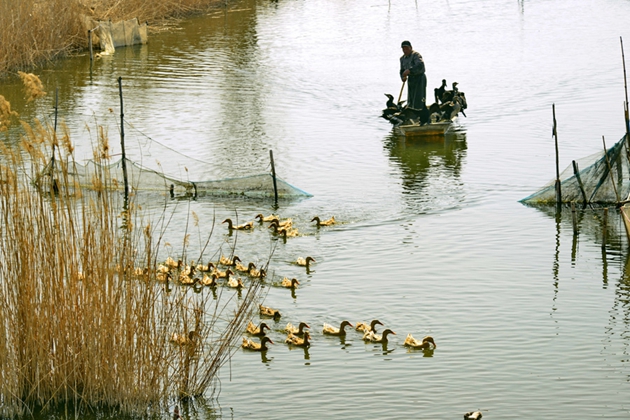
A photo shows a fisherman and his cormorants fishing in the tributaries leading to the Mata Lake in Huantai county, Shandong province. [Photo By Ju Chuanjiang/China Daily]
Living and working in Yuyi, a village on Mata Lake in Huantai county in Zibo, Shandong province, Gong Jianmin said that one of his greatest joys has been watching the improvements to the lake's environment over the past decade.
Gong patrols the lake by boat five times a month to see if wastewater is being discharged into it or if any garbage is being dumped.
"This used to be a two-meter-wide ditch full of smelly water, but now it is a 30-meter-wide waterway full of clean water," Gong said of one waterway that flows into the lake.
Mata Lake and the surrounding wetlands are an important wetland system in Shandong province. Farmers who live on the lake fish in it and harvest lotus roots.
In the 1990s, Mata became heavily polluted as a result of industrial development, and its area shrank from 96 square kilometers to just 20 sq km, making life for farmers living on its shores difficult.
Since 2012, the local government has spent 300 million yuan ($43.1 million) reconstructing six wetlands around rivers that flow into Mata Lake to restore the environment.
In addition, they dredged 130 km of waterways leading into the lake.
Now Mata and its rivers can store 25 million cubic meters of water, eight times more than a decade ago, according to statistics from the local bureau of ecology and environment.
"Decades ago, our village suffered from droughts in the summer and flooding in the autumn as a result of blockages, and the wetland system didn't work well," said Song Kaicai, a 59-year-old from a village close to Mata. He often comes to take photos of the lake these days.
"But now, we don't need to worry about droughts and flooding anymore as the wetlands and the water conservation facilities are doing a good job of storing water," he said.
"Mata Lake wetlands have regained their vitality, with wild plants flourishing around its edges and the number of bird species increasing substantially," said Song Qiang, head of the Huantai environmental authority, adding that 174 animal species have been recorded in the lake's vicinity.
Song Kaicai has photographed some 30 bird species in the wetlands during the past decade.
Since he saw a pair of reed parrotbills, an endangered marshland species, for the first time in the winter of 2019, he said he has seen flocks of them in the wetlands year round.
In addition to reed parrotbills, Song Kaicai has also seen other birds such as swans and great crested grebes.
"More and more birds are choosing Mata Lake as their home, which is evidence that the wetland environment is good," he said.
In addition to traditional methods of making a living on the lake such as fishing, some farmers have found new ways.
Song Xiangfeng runs a business making reed products and is planning to expand. "There are around 660 hectares of reeds growing around the lake, providing quality material for us to make straw," he said, adding that reed straw is environmentally friendly.
To raise the incomes of more farmers, some towns around the Mata Lake wetlands are planning to develop rural tourism, according to local governments.